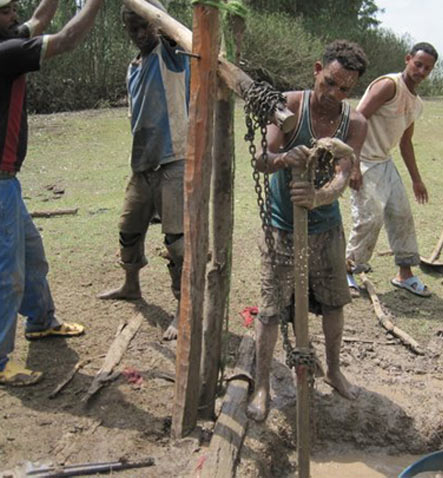Smallholder farmers without access to water are limited to rainy season crop production.
As rains can be unreliable, improving smallholders access to water reduces their vulnerability and improves food security. Groundwater sustains the lives of an estimated 400 million people in rural Africa, yet it is vastly underdeveloped in many regions.
There are large untapped groundwater reserves which could help millions more to grow more and earn a better living. In Ethiopia alone recent studies indicate that groundwater reserves may be far greater than the commonly used estimate of 2.5 billion cubic meters.
Groundwater potential is shaped by complex geological formations and the diversity of the topography, climate and soil. It is therefore well suited to localized, small scale development.
[row][column size=”1/2″ center=”no” class=”DarkBlueBackground”]
How to Support
One solution for reliable and affordable access to shallow groundwater resources is manually-drilled wells. While this practice is prevalent and highly developed in many Asian countries, it is not widely available in Ethiopia.
Manual drilling is viable only in specific hydro-geologic settings. IDE ran a pilot study in Ethiopia where they had 80% success rate in manual well drilling, but investments in field-level data collection and mapping are necessary to determine suitable areas and the number of smallholder farmers who could benefit.
Ethiopia – Ground Water Ghana – Ground Water
Where to Invest
Shallow groundwater irrigation has the potential to provide profits to smallholder farmers. Reaching that potential requires greater knowledge about groundwater availability, improved policy and strategic support, and specialized extension services. Groundwater has emerged as the main source of irrigation for farmers in India and much of it has been through private investments. Revising grounwater policies, as well as provision and pricing of electricity could propel smallholder farmers on a path to higher agricultural growth.
[/column] [column size=”1/2″ center=”no” class=””]
Manual well drilling: A business plan
Once a well is drilled and farmers are able to access water, they have a variety of pump options and water storage technologies; and of water application methods.
In their pilot work, IDE found that manual well drilling could improve the livelihoods of a significant number of smallholder farm households.
Developing an industry of private sector manual well drillers requires simultaneous investments in driller training and certification; creating supply chains for manual drilling supplies; creating demand from farmers for manually-drilled wells; supporting improved and sustainable smallholder agronomic production; and linking farmers to processing, storage and market opportunities.
This document details a model for private sector manual drilling and the investments required to catalyze the sector.







